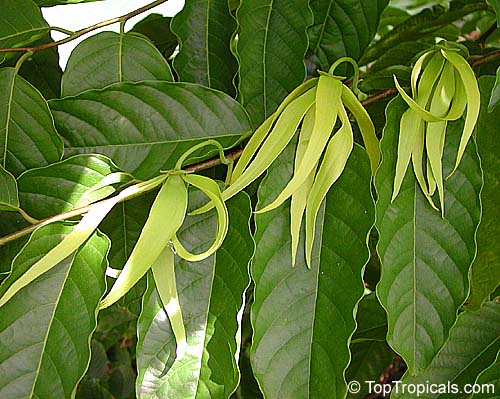The Ylang-Ylang: Queen of the Perfume World...
The Bearer of an Ideal Fragrance
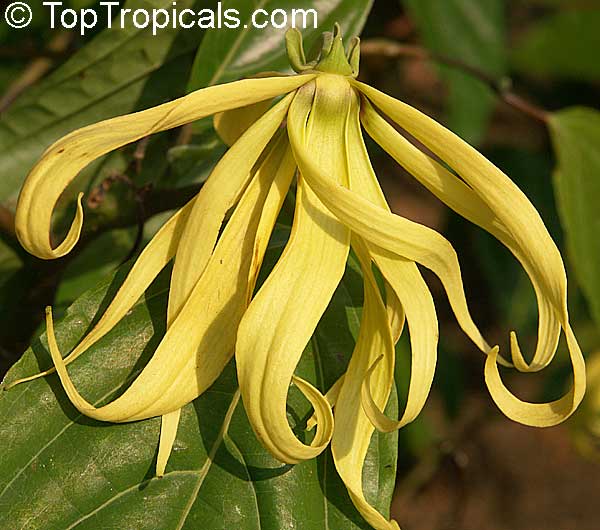
Two persons and one plant participated in the creation of the world famous fragrance, "Chanel # 5."
The inventors of this renowned perfume were Gabrielle "Coco" Chanel, and Ernest Bo (Beaux) who was born in 1881 in Moscow. Bo was the son of the owner of the perfumery company Rallet, which delivered perfumery to the imperial court. He later became Rallet's director.
When Bo emigrated after the Bolshevik Revolution in 1917, the factory continued to exist, and in Soviet times was called "The Red Moscow." If it hadn't been for the Revolution, "Red Moscow" and "Chanel" most likely would have remained unknown.
Chanel asked Bo to make "an ideal smell for a woman." In 1921, he presented two series of samples: from the 1st to the 5th, and from the 20th to the 24th. Chanel chose the 5th, which consisted of the aromas of a rose, a jasmine and Ylang-Ylang flowers.
When questioned about giving it a name, she answered that the collection would be on sale on the 5th day of the 5th month, and consequently it was called "Chanel # 5."
In the 1950's, a quip from Marilyn Monroe created instant worldwide popularity for Chanel # 5. When asked by journalists what she wore in bed, Marilyn smiled and answered "Chanel # 5."
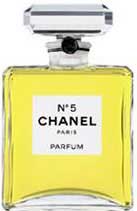
"Les Ferrets de la Reine" - Queen's Luxury Pendants
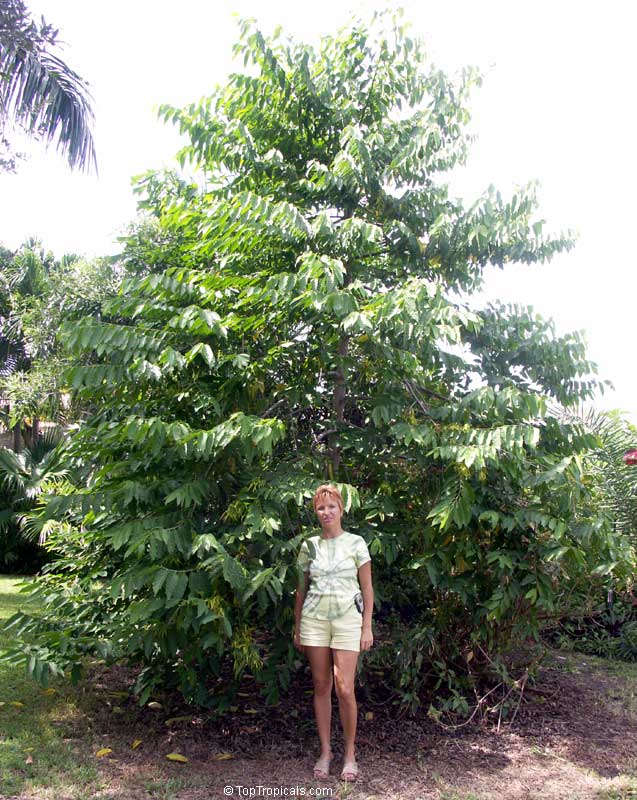
Ylang-Ylang (Cananga odorata) is a large evergreen tropical tree of the Annonaceae family, which grows to 100 ft. in height. It has drooping branches and yellow, long-petaled flowers whose fragrance can be smelled from a distance of 30 ft. or more. It originated in Indonesia and is widely distributed in Southeast Asia, the Philippines, and the Polynesian islands.
The Annonaceae family is comprised of about 130 tropical and subtropical plants, among which are many well-known exotic fruit trees such as the so-called "custard-apples." These include a Sugar Apple (Annona squamosa), Soursop (Annona muricata), Cherimoya (Annona cherimola), and Rollinia deliciosa. The family also includes many other fragrant plants, such as Desmos (Desmos chinensis) and Artabotrys (Artabotrys hexapetalus).
Ylang-Ylang grows from seeds and begins to bloom in three to four years. The flower changes color from pale green to lemon yellow. Old flowers have a dark yellow color with brown spots and are about 2" long with narrow petals gracefully hanging down, reminding one of an elegant accessory for a luxurious designer evening dress.
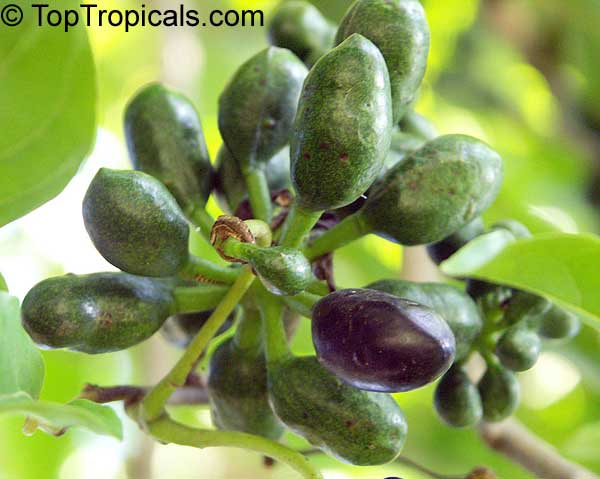
In addition to its wonderful fragrance, the plant blooms practically year round. Its branches are entirely covered with clusters of flowers and dark green oval fruits. Ripe fruits have a black color. Unlike some Annonaceae, Ylang-Ylang fruits are not used in foods; however they are quite edible and have the tart but pleasant aroma of a conifer or juniper.

 Even when not in bloom, the tree is very beautiful with branches that
look like those of Christmas trees. Its leaves are large, dark green and
are located on the branch in pairs, which creates the illusion of a "Christmas
Tree".
Even when not in bloom, the tree is very beautiful with branches that
look like those of Christmas trees. Its leaves are large, dark green and
are located on the branch in pairs, which creates the illusion of a "Christmas
Tree".
There is also a dwarfish version of the Ylang-Ylang tree, Fruticosa, which is a small tree or a bush that grows up to 6 ft. tall and starts blooming when the plant is only 1 to 1? feet tall. The spicy aroma of the Fruticosa flower is not as strong as that of the flowers of full-sized trees.
However, this dwarf is very popular among gardeners because it is ideally suited for indoor or patio container culture.
Fruticosa flowers have a more graceful form with the ends of the petals slightly twisted inside, resembling the scalloped edges of a mollusk shell.

Mourning Over a Beloved One
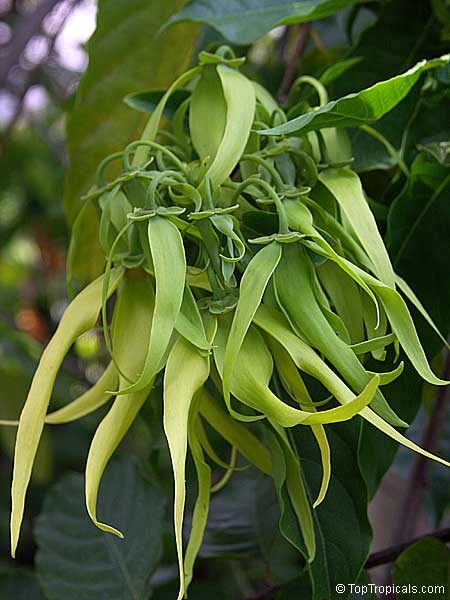
In Tagalog, one of the most widespread languages of the Philippines and the second most-spoken Asian language in the USA after Chinese, "Ylang Ylang" (to be exact, "alang-alang") means "a flower of all flowers."
The Philippine legend tells about a married couple who had everything in their life except children. In a dream, the gods came to them and promised to grant them a daughter, provided that the girl should never touch a man once she matures. The girl was named Ilang ("Flower"). She grew to be a true beauty, and there was no lack of men asking to marry her, but her parents guarded her in order not to break their agreement with the gods. One day when the parents were not at home, Ilang went to her garden to collect a bouquet of flowers. Unexpectedly, there appeared a young man who for a long time had been in love with her.
He held her by her hand and said, "I love you, be my wife." Instantly the girl disappeared, turning into a small tree with very fragrant flowers. "Ilang! Ilang!" cried the young man. Since that day, it is said that the young man continues to wander the magic garden, calling out her name throughout eternity.
Mystery of Fragrance
The flowers of the Ylang Ylang are pollinated by night moths; therefore the most intensive smell is released from dusk until dawn. The flowers to be used by the distillation process are picked at sunrise when their aroma is the most intense.
Essential oil is produced using a method of distillation, unlike some other flowers such as the jasmine. The essential oil of jasmine is extracted by its absorbsion into a layer of fat on which the flowers are laid. Only then does distillation become a part of the process. The fat is distilled to obtain the aroma. Those who have read the novel "Perfume" by Patrick Suskind are quite familiar with the theory of aroma extraction…

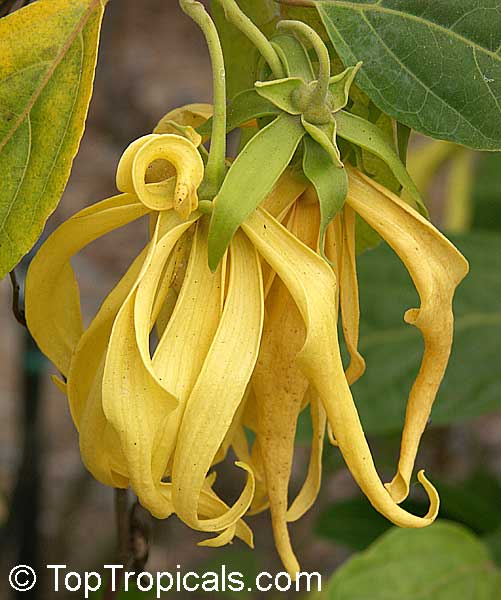
The distillation process takes 14 hours and begins in the early morning with the picking of yellow flowers. A copper, hermetically-sealed jar containing approximately 200 pounds of flowers is filled with 15 gallons of water. The result of distillation is about 1-2 liters (or 1-2 quarts) of oil with the most intense aroma that is called "Ylang Ylang Extra."
Then the process of distillations is repeated and lower-grade oil is produced. It is called simply "Ylang Ylang oil." The various gradations of concentrated aroma are numbered 1, 2 and 3. Lastly, the distillation produces oil called "Cananga Oil" which is used in fragrant soap manufacturing.
Sometimes instead of distillation, the flowers are used directly for preparation of fragrant soaps, candles, and other products. We put a flower on our car's dashboard. When it was heated by the sun, it let out a delightful aroma that lasted several days and was far better than any air-freshener.
Amazing Economics
From ancient times, girls in Philippines decorated themselves with Ylang Ylang flowers, from which, together with flowers of Sampaguita (Jasmin Sambac or "Maid of Orleans") they made garlands resembling Hawaiian leis. These sold for 5 pesos (currently, $1 US = 55 pesos). A kilogram (2.2 pounds) of Ylang Ylang flowers costs about 20-50 pesos (less that $1 US). From a kilogram, it is possible to produce about 10-20 milliliters (less than an ounce) of the best quality oil. A liter (about 1 quart) of oil in the Philippines costs from 7,500 up to 10,000 pesos ($150-$200), depending on the quality.
On the Internet, a mere 10 milliliters of oil of Ylang Ylang costs about $10-20 depending on the grade. The second grade Ylang Ylang oil is not inferior, but more of it is required to create desired fragrance intensity. Note that when one buys Ylang-Ylang oil on the internet, he or she has to pay 10 to 20 times as much as it costs in the Philippines. That's enough profit to think about growing one's own groves of Ylang-Ylang. However, if you really decide to do this, then you should go either to the Philippines or to the Comoro Islands.
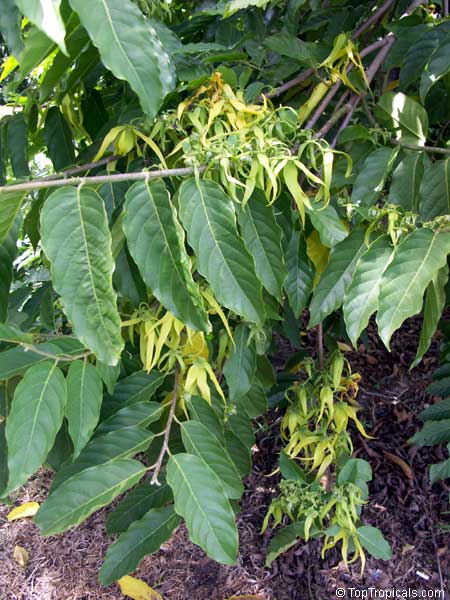

Before the First World War, the Philippines was the center for producing oils. The German pharmacist F. Shtek, the owner of the first Manila drugstore, "Bodice Boer," first received high-quality Ylang-Ylang oil in the second half of 19th century. The drugstore was located on the Escolta in Manila, which was one of its most fashionable streets, similar to 5th Avenue in New York. This is why the fragrant oil won popularity in high society all over Philippines, and then in Europe and America. Before the first World War, the Philippines had a monopoly in the manufacture of this oil, but after the war, Germany had other priorities, and France transferred cultivation of the trees to the Comoro Islands.
Most likely, "Coco" Chanel received the oil from the Comoro Islands because, by 1920, cultivation of Ylang-Ylang in the Philippines had sharply declined. At the best of times, the Comoro Islands produced 90% of the world's Ylang-Ylang oil from 1.2 million trees. During the 1960's to 1970's, this production declined due to the introduction of synthetic fragrances on the world market.
With the increasing popularity of aromatherapy, there has been a revival of commercial products using Ylang-Ylang from the Philippines. In the provinces of Pampanga and Tarlac there are thousands of hectares (1 hectare = 2.47acres) growing 20,000-30,000 trees. It's certainly not 1.2 million, but just imagine the aroma! It must difficult to sell perfume where everything smells like Chanel # 5!
Essence of Passion
In the Philippines, Ylang Ylang flowers were considered good for driving away malicious spirits. In Indonesia, it was prized as an aphrodisiac and the flowers were scattered on the beds of the newly married. Ylang Ylang oil was recommended for women in harems to heighten sexual appeal. In China, the clothes of people who could afford it were sprayed with Ylang Ylang oil before storing them in chests. (The smell of a winter coat, pulled out from a chest was certainly more pleasant than the smell of the naphthalene that is used now).
Besides perfumery, Ylang Ylang flowers also had medicinal applications. In the Philippines, the flowers were crushed and applied to the sites of insect stings and snake bites. The oil was also used for skin and hair because it was thought to improve hair growth. In England, in second half of the19th century, Ylang Ylang was one of the components of oil used for "growing hair." Whether it really helped hair growth, we don't know, but, in any case, a bald head must have smelled very pleasant.
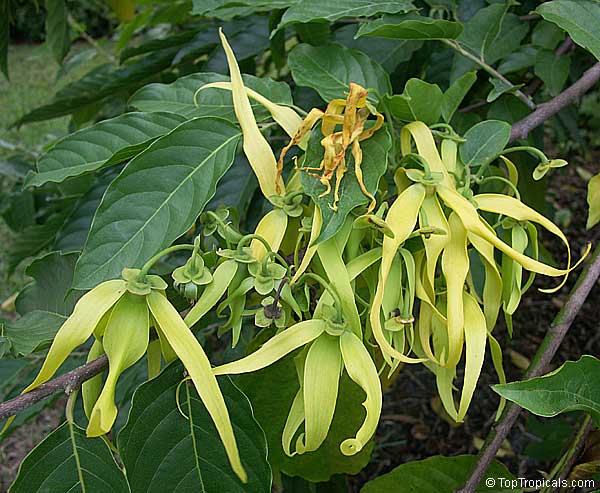
 It is now fashionable in aromatherapy to use Ylang Ylang oil, which
is usually the third gradation, to alleviate stress, anxiety, and high
blood pressure. Since it is considered a calming aroma, you can probably
keep your neighbor's aggressive dog at bay by planting Ylang Ylang in
your yard.
It is now fashionable in aromatherapy to use Ylang Ylang oil, which
is usually the third gradation, to alleviate stress, anxiety, and high
blood pressure. Since it is considered a calming aroma, you can probably
keep your neighbor's aggressive dog at bay by planting Ylang Ylang in
your yard.In addition to Chanel #5, Ylang Ylang is used in other perfumes such as "Aqua De Gio" by Giorgio Armani, "Poison" by Christian Dior, and "Elise Fields" ("Champs Elysee") by Guerlain.
Ylang Ylang Oil Aromatherapy
As a bath oil: Add 1-2 drops to a bath for a soothing effect. Other variations: Add 3 drops of lavender, 2 drops of Ylang Ylang, and 2 drops of juice from a grapefruit.
For Massage: Add 1-2 drops of Ylang Ylang to odorless massage oil. A more refined recipe recommends also adding 5 drops of sandal oil, 4 drops of pink oil and a droplet of patchouli. This mixture will guarantee a great massage.
An aromatic mix: add 8 drops of Ylang Ylang, 8 drops of lemon juice, and 8 drops of basil. If you add a few drops of this mixture to a therapeutic spray, it will work well to relieve weariness and stress, etc.
A Cologne: Obtain 5 ml (about 1/5 oz.) of spirits (It is desirable to do your own clearing rather than using denatured alcohol). Mix the spirits with distilled water to a 50% concentration. (Probably one could use vodka if no other spirits are available). Add 12 drops patchouli, 3 drops of geranium sap, 2 drops of Ylang Ylang, and a little bit of cinnamon (leaves or bark will do). This mixture will produce very fine cologne.
A potpourri: Mix in a glass vessel (that has a hermetically-sealed cover) a little oil of Ylang Ylang (or flowers), a little dry tangerine/orange/lemon peel, some leaves or bark from a cinnamon tree, a bay leaf, and a few leaves from a carnation plant. Keep the vessel closed for 3-4 weeks, periodically shaking it. The resulting tincture can then be used to scent linens, bed sheets, clothes, etc.
You can create your own unique recipes using Ylang Ylang. Experiment and awaken passions!
Cultivating Ylang-Ylang

Cananga odorata is an excellent landscape tree, but unfortunately, it hasn't been widely introduced yet.
Its features are numerous:
1) it is very fast growing - you'll have a mature tree in no lime
2) its nice columnar shape requires no special pruning
3) its roots are noninvasive
4) it has practically no pest problems
5} it is not messy because it doesn't drop much leaves, and it's evergreen
6) its branches are flexible in the wind
7) it blooms almost year-round and will suffuse all of your neighborhood
with a fine fragrance.
Even though Cananga odorata is considered lo be a tropical plant, it prospers in most subtropical zones and once established, can survive short periods of cold (above 30°F anyway). As is characteristic of every warm-climate plant, it doesn't like chilly winds, but at the same time, the tree can withstand pretty strong wind movements.
As a landscape tree, the Ylang-Ylang offers, besides its flexibility and year-round aroma, two more special features - it is extremely fast growing and big. Once planted in the ground, the tree reaches its maturity within only one to two years, starts blooming, and creates a nice, almost Christmas-Tree-like canopy with drooping branches. Since in only a few years, it can become as high us 60 ft tall and 15 feet wide, you need to plan ahead! At the same time, the Ylang-Ylang's roots are not invasive, so it shouldn't damage driveways or pavements.
Light. Provide full sun to ensure better flowering.
Water & Humidity. Water your Ylang-Ylang daily for the first 2-3 weeks after you plant it. Then regular sprinkler irrigation will be sufficient. Cananga is a rainforest tropical tree that thrives best in a high-humidity environment.
Fertilization. Fertilize the plant with one-half dose of blooming-grade balanced fertilizer at least once a month during the growth period to encourage blooming; no fertilizing is required from the fall to the early spring.
Pests. The tree is practically pest-free. No special treatments are usually required to keep it healthy.
Sometimes, creative gardeners who lack room in their gardens train the plant into a shrub. Such a compact Ylang-Ylang will still provide wonderful perfumed flowers year round. The procedure must be started as early as on 8-10 inch seedling by pinching the very top point of growth. Don't wait until the seedling becomes too woody, or when you plant in the ground, the tree will sprout up a long stem. If done in time, trimming can create a nice shrubby look.
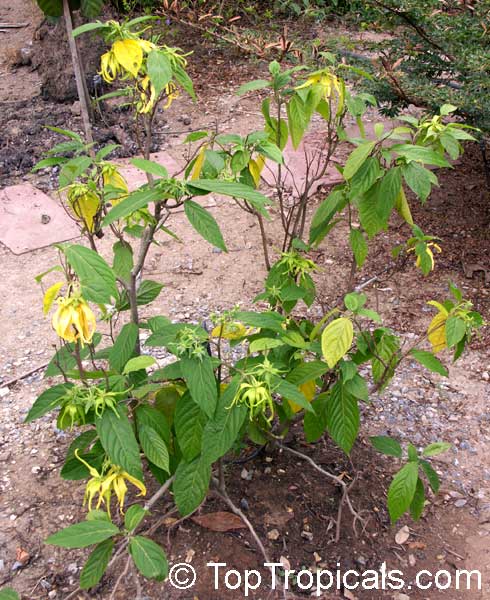
Initial Care after Shipping

If you live up north and order this plant from a mail-order nursery, then the following information may help you.
The low humidity the Ylang-Ylang experiences during shipment may cause some leaves to drop off or turn yellow/brown/black. Once your plant arrives, pot it immediately in well-drained potting mix. Water it well and place the pot in a bright shade location. Placing a water tray with pebbles under the pot will maintain a higher humidity level, as will frequent misting or a plastic bag over the foliage.
If you grow this plant indoors with AC, it might easily die since air conditioning greatly reduces humidity.
Normally, Cananga recovers from transportation stress in a week or two. If the stem was bent slightly in the box, do not worry - it will straighten up in a few days. If you provide the right conditions and proper care, your Ylang-Ylang tree will sprout new growth in just a few weeks.
If the leaves turn brown or black, the humidity level is too low. Another important factor - avoid too large a difference in day/night temperatures.
Growing Cananga odorata requires some patience - just be careful with your plant and the rewards will be great!
Upacked ylang-ylang plants after 8 days shipping
